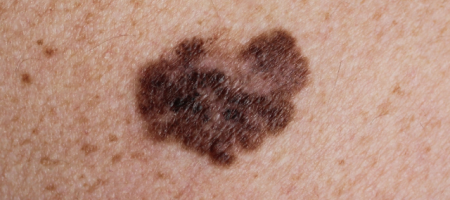Melanoma

Melanoma is a type of skin cancer that develops in the skin cells called melanocytes (the pigment cells of the skin) and usually occurs on the parts of the body that have been overexposed to the sun. Rare melanomas can occur inside the eye (ocular melanoma) or in parts of the skin or body that have never or rarely been exposed to the sun such as the palms of the hands, the soles of the feet or under the nails.
Melanoma is the third most diagnosed cancer in Australia, and it is estimated that one in 17 people will be diagnosed by the time they are 85.
Australia, along with New Zealand have the world’s highest incidence rate of melanoma.
Symptoms
Often melanoma has no symptoms, however, the first sign is generally a change in an existing mole or the appearance of a new spot. These changes can include:
- colour – a mole may change in colour, have different colour shades or become blotchy
- size – a mole may appear to get bigger
- shape – a mole may have an irregular shape, may increase in height or not be symmetrical
- elevation – the mole may develop a raised area
- itching or bleeding
Other symptoms include dark areas under nails or on membranes lining the mouth, vagina or anus.
New moles and spots will appear and change during childhood, adolescence and sometimes during pregnancy and this is normal. However, adults who develop new spots or moles should have them examined by their doctor.
Causes
There is overwhelming evidence that almost all melanomas are the result of previous sun exposure. Most melanomas in younger Australians (under 50 years) are due to occasional sun exposure of the kind that produces sunburn. Childhood sun exposure is a particularly important contributor to these melanomas. Melanomas in older Australians (over 50 years) are more strongly related to regular sun exposure over a long period.
Treatments
All melanomas are treated surgically by removing both the melanoma along with a safety margin of normal appearing skin around it.
The width of the safety margin removed varies according to the depth of the melanoma. Sentinel lymph node biopsy should be considered for all patients with melanoma greater than 1 mm in thickness and for patients with melanoma greater than 0.75 mm This procedure identifies the first lymph node that drains the site of the melanoma and then the lymph node is removed at the same time as a wider safety margin around the melanoma itself. If melanoma is present in the lymph node the risk of further spread of the melanoma is greater and further treatments may be offered to help reduce this risk.
Sentinel node biopsy may provide information about your risk for spread of melanoma beyond the skin.
Treatment with drugs targeting specific melanoma mutations (targeted therapy) or immunotherapy are used to treat advanced spread that cannot be surgically removed. These drugs have greatly improved the prognosis or outlook for patients with advanced melanoma that has spread.
Resources
For further information, you can visit the following resources:

